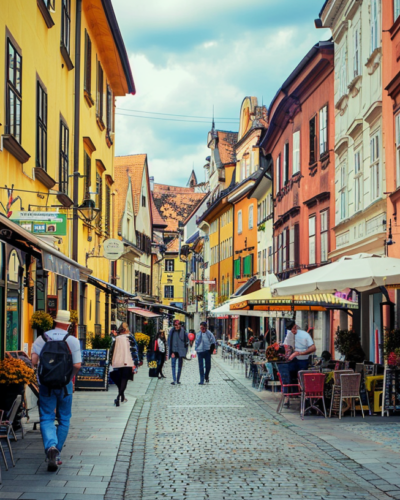From neon glows to illuminated skylines, find out how city lights have shaped our nocturnal landscapes and 20th-century architecture.

At night, city lights don’t just illuminate — they transform. Nocturnal architecture, a term that captures the essence of cities as they come alive after dark, speaks to more than the absence of daylight; it’s a symphony of light and shadow that shapes our experience of the urban landscape when the sun sets. With how the 20th century witnessed a remarkable shift in architectural design, we’ve witnessed how more buildings seem to function at night, becoming a totally new structure that are as, if not more, significant during the day. Such transformations were powered by the advent of artificial and graphic lighting, not to mention the desire to showcase modernity and progress through illuminated facades and skyline contours.
Eventually, the concept of nocturnal architecture emerged on a worldwide scale as cities began to expand vertically, and the skyline morphing into a canvas for expression. Architects and designers started to recognize the potential of artificial lighting as a tool to highlight features, create ambiance, and convey messages. Iconic buildings and bridges became beacons of light, their details accentuated or their presence announced through strategic lighting.
Of course, this design philosophy didn’t just change the aesthetics; it revolutionized how buildings were used and perceived, turning them into landmarks of the night.
Today, the proliferation of city lights also signifies the endless bustle of urban life, with bright neon signs and glowing billboards becoming symbols of always-on cities. The interplay of light and structure in architectural design allowed for a new type of interaction with the built environment, one that continues to evolve with technology and artistic vision.
As you continue reading, you’ll discover how nocturnal architecture shapes the identity of a city and influences our cultural and social interactions after dark, all while painting the town with city lights that speak to the soul of the metropolis.
Join us in exploring these illuminated marvels that define the world’s greatest cities and the architectural ingenuity that brings the night to life.
The Evolution of Artificial Lighting in Architecture
As dusk falls and city lights begin to punctuate the skyline, the true essence of nocturnal architectural design comes alive. It’s here, in the transformative glow of street lamps, neon signs, and illuminated facades, that modern cities reveal their second skin. The development of artificial lighting has not only enhanced the functionality of urban spaces but has also given architects a dramatic medium to sculpt the night.

The evolution of city lights has been symbiotic with the advancements in global architectural design. The early adoption of gas lamps introduced a gentle glow to modest streets, beckoning the Art Nouveau period to integrate light into ornamental design. However, it was the electrification movement that catalyzed a revolution in the way imposing buildings were perceived after dark. Suddenly, structures could be clad in an aura of light, making them beacons of the industrial age’s progress and prosperity.
Architectural design in the 20th century took this new tool and ran with it, creating iconic silhouettes against the nocturnal landscape. Buildings were designed with consideration for their nighttime persona, utilizing city lights to enhance their forms and features. The Chrysler Building’s crown, for instance, became a luminescent sculpture in the New York City skyline — its gleaming art deco details a testament to the era’s optimism and flair.
Iconic Examples of 20th-Century High-Rise Buildings
The skyline of any major city is undoubtedly a testament to the marvels of 20th-century architectural design, with high-rise buildings towering as storied monuments of an era’s technological and artistic ambition. Among these, certain edifices have become iconic, not just for their stature but also for their distinctive use of city lights that transform the urban nightscape into a wonderful afterdark sight.
One such iconic structure is New York’s Empire State Building. Opened in 1931, this Art Deco masterpiece in the heart of the Big Apple became the standard-bearer for the architectural design of skyscrapers. The Empire State Building’s tower lights, capable of displaying 16 million colors, have become a prominent feature of the city’s nighttime architecture, celebrating holidays, events, and achievements.
In Chicago, the Willis Tower, formerly known as the Sears Tower, stands as another colossus of 20th-century architectural design. Completed in 1973, it dominated the skyline as the tallest building in the world for nearly 25 years. Its black aluminum and bronze-tinted glass exterior reflect the city lights and sky, creating a sleek profile that is a hallmark of Chicago’s cityscape (as evident in structures like the Staypineapple Hotel, designed by Daniel Burnham).
Moving to the West, the Transamerica Pyramid in San Francisco, with its unique pyramid shape, altered the architectural narrative of high-rises. Completed in 1972, its silhouette is a staple of the San Francisco skyline, and its apex city lights can be seen from miles away, serving as a guiding beacon in the night.

Of course, these towering structures are more than just places of work or landmarks; they also symbolize the essences of their cities. Glistening with city lights after dusk, they stand as beacons of the 20th century’s architectural design prowess, embodying the aspirations of their time, while their illuminated forms continue to enchant and define the urban experience, proving that buildings are not just physical entities but also canvases for light, culture, and identity.
The Aesthetic and Functional Roles of Lighting
In the realm of architectural design, lighting serves a dual purpose: it is both an aesthetic statement and a functional necessity. This means the strategic use of city lights in buildings does more than just illuminate; it accentuates architectural features, shapes perceptions, and enhances the functionality of spaces.
Its aesthetic role in architectural design is evident in the way it can transform the ambiance and command of a structure when night falls. Well-placed lighting can highlight the elegance of a building’s lines, the texture of its materials, and the grandeur of its form. For instance, the soft glow on the façade of a historical building can evoke a sense of warmth and heritage, while the sharp, dynamic city lights on a modern skyscraper can convey innovation and progress.
Functionally, lighting ensures safety and navigability. It guides inhabitants and visitors through spaces, from the grandest of lobbies to the humblest of stairwells. Mind you, city lights are not merely for show; they also play a critical role in urban design, facilitating movement and interaction after dark and contributing to the security of public spaces.
Moreover, the role of lighting in architectural design has expanded with the advent of sustainable and smart lighting solutions. LED technology and motion sensors not only reduce energy consumption but also adapt to the needs of occupants, embodying a future where city lights respond in real-time to the living city.

The Future of Urban Landscapes and Lighting Design
The future of urban landscapes is intrinsically linked to the evolution of lighting design, where city lights will play a pivotal role in shaping the nocturnal identity of metropolises. The convergence of technology and creativity heralds a new era in architectural design, one where lighting is not just an add-on but a fundamental aspect of urban planning.
Innovations such as smart lighting systems (which can be remotely controlled to adapt to varying conditions), are set to revolutionize the way cities use city lights. Imagine street lights that dim or brighten based on pedestrian traffic, or facades that change color in response to environmental triggers. Such advancements will not only enhance energy efficiency but also create dynamic urban environments that respond in real-time to their inhabitants.
The integration of lighting with digital technology opens up a myriad of possibilities. City lights can be used to display information, interact with citizens, and even aid in crowd management by altering patterns and intensities. The architectural design of the future sees buildings as canvases for light art, with facades doubling as screens for cultural expression.
As we move forward, city lights will be more than mere illumination; they will become tools for sustainability, interaction, and expression. This evolution in lighting design is poised to transform our urban experiences, making our future cities not only brighter but smarter, safer, and more responsive to the needs of society.
Experience Magical City Lights Wherever in the World with This City Knows
Delve into the radiant world of urban exploration where city lights are not just beacons in the dark, but symbols of life and energy. Uncover the secrets of architectural design and experience the vibrant nightscapes across the globe with This City Knows as your Guide.
Visit This City Knows for exclusive insights and tips on how to make your nocturnal travels and urban explorations unforgettable.








